
How To Identify Mold In New Jersey Homes
Identifying Conditions & Causes For Mold Growth in New Jersey Homes
NJ homeowners will send us pictures asking if the stuff growing on their walls or cielings is mold. So we’ve created this page to help you identify mold, what’s causing it & what to do about it. Best of all without any fancy equipment!
Identifying Red Flags –
A “red flag” is defined as any situation or condition that is favorable for mold growth.
Many times the first red flag you see is visible mold. This is usually an area that is exhibiting signs of water intrusion or where the inspector senses “musty” odors. Or the occupant states they have mold related health symptoms.
When a red flag is identified, the source of the red flag (water) must also be identified. Depending on what specifically has been identified, the inspector may wish to take samples for testing.
Visible Mold Growth – Addressing the maturity stage of mold.
Example 1 – When mold is visible & easy to identify by eye.
Most of the pictures we see are very obviously mold. For instance, this is obviously mold:
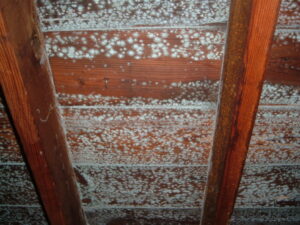 Mold always begins with circles. It doesn’t always end this way, but scattered circles are the earliest tell tale sign of mold.
Mold always begins with circles. It doesn’t always end this way, but scattered circles are the earliest tell tale sign of mold.
When mold is immature, or taking over a new area, the distance between the circles is greater.
As mold begins to mature (gain access to water) it will form tighter clusters.
You can see towards the center that the circular formations are still visible. The spherical shape is still there. But where the mold has matured beneath it… it starts to look like one solid blob.
This aspergillus mold was identified in an attic in New Jersey, where the ventilation system had stopped working. MMRG was able to restore the attic by replacing the ventilation system & encapsulating the attic.
Example 2 – Immature mold.
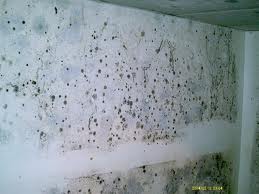
In this example we’ll highlight the difference between immature mold vs mature mold.
When identifying mold in your NJ home, the first thing to assess is how mature it is. As mature mold is far more dangerous.
Immature mold will form loose clusters with distance between the hyphae or circles.
These immature molds are usually the result of humidity or ventilation problems. They grow slower. They tend to grow in fractured stages. For instance mold can take root in NJ between the months of April to September. It can lay dormant or undeveloped till the following yr, when it gains access to more water. Then it can fully mature. Once mold reaches maturation it will release much higher levels of harmful mycotoxins.
As we will show in our next example.
Example 3 – Mature Mold
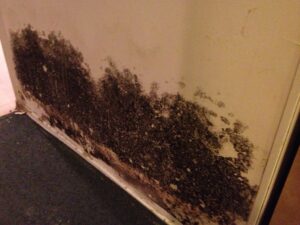
When mold gains regular access to high amounts of water, it will start to form tight clusters.
It can start to look like black astroturf growing on your walls.
Mature mold will also protrude 1-2″ from the surface of the walls. If you put gloves on & run your fingers over it, you can feel it growing out from the surface. And it’s normal to see what looks like black, greasy “hairs” (known as “hyphea”).
This type of mold is a huge red flag.
The mold in our second example was growing due to ventilation issues. This lead to occassional condensation that allowed mold to sporulate on the walls. But mold that feeds off humidity can take a long time to reach maturation. Due to sporadic or inconsistent access to water.
The mold in our third example was growing from a leak in the basement. This mold reached full maturation in a matter of 2 1/2 months.
It can seem confusing as the immature mold can take up more space on walls. So it appears more threatening by eye. And it can still pose danger. But the mold in our last example is much more dangerous. Even though it’s isolated to a smaller area. Fully mature mold will release much higher levels of mycotoxins.
If you identify mold in your NJ home that has formed tight clusters like this, please give us a call! This is something that needs to be treated by professionals.
Identifying Cosmetic vs Noncosmetic Mold
This is another common issue we see in pictures that people send us. But you can quickly assess the environment, using your senses, to identify how dangerous the mold is. These guidelines aren’t perfect. Sometimes cosmetic mold can be dangerous. Sometimes noncosmetic mold is safe. But most of the time the opposite is true.
Example 1 – Cosmetic Mold
Cosmetic mold is mold that grows on hard, smooth surfaces. These surfaces include tiles, vinyl, plastic, metal, marble, any material that is hard & nonporous.
New Jersey homeowners will often send us pictures of cosmetic mold. Wondering how dangerous it is.
Most the time it’s not a problem! Why? Because mold needs to form roots or hyphae to penetrate beneath a surface. This is how it absorbs nutrients that it uses to mature & generate toxins. Mold thats growing on hard surfaces, even if it looks scary, it generally won’t pose a threat.
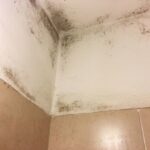
This is cosmetic mold growing at the top of a shower. Sometimes you’lll see it on the tiles. Sometimes in the tub or on your vinyl barrier.
It’s also common to see it on window sills or window mounted AC units. Where it will sometimes grow on the styrofoam.
This type of mold can smell. And they can emit low levels of toxins. But cosmetic mold is not the type of mold where you need to evacuate a home & run a full quarantine to clean everything. Mycotoxins from cosmetic mold will rarely surpass dangerous thresholds. As we normally see when sending mold tests to labs in NJ.
This doesn’t mean bathrooms can’t generate toxic mold. They can. If a water leak in the bathroom causes mold to grow on sheetrock, that would classify as “non-cosmetic” mold. Which we’ll cover next.
Example 2 – Noncosmetic Mold
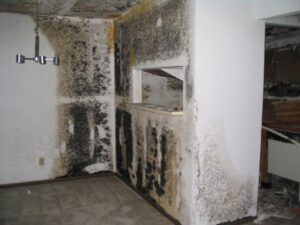
Noncosmetic mold is a completely different type of mold. It grows on “soft”, porous material like wood, sheetrock, insulation, wallpaper, anything that is porous. It can also grow on concrete though most concrete will have natural moldicides in it.
This home in New Jersey was being renovated and had a huge infestation of non-cosmetic, stachboytrs mold growing all over the sheetrock. It had been flooded multiple times. The mold appeared during the warmer spring months. You can see tighter clusters towards the bottom where water pooled by the floors. Then looser clusters towards the cielings.
This type of non-cosmetic mold is a huge red flag. You don’t want to find mold growing in this type of environment. You never want to use bleach either. Bleach can form chlorinated mycotoxins which are more toxic than what existed before. These mycotoxins are also more stable. Meaning they are more resilient to heat & harder to clean.
One caveat we need to add is HVAC systems. HVAC systems are one location where cosmetic mold can grow, while posing the same dangers as non-cosmetic mold. This is because HVAC systems are made with sheet metal. So they are smooth & nonporous. But as dust collects inside the HVAC system, the surface becomes porous. And will adopt the features of non-cosmetic mold.
Mold growing in HVAC systems needs to be taken seriously. While mold growing in wall mounted AC units is generally not dangerous.
If you identify mold like this in your New Jersey home, call a professional remediation company.
MMRG offers mold remediation & basement waterproofing services to call of NJ. Thanks for visting our website!
